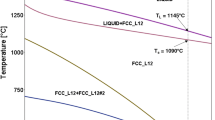Abstract
High entropy alloys are novel and innovative metallic materials, which have intensively moved into the focus of research over the last decade. The high entropy effect in those multi-component alloys promotes the formation of a characteristic crystal structure, the random solid solution, which features unique material properties, and reduces the number of possible brittle phases. In this publication, the influence of gallium as a melting point depressant on the melting range and the microstructure of the two-phased equimolar CoCrCoFeNi were determined. In order to integrate the vacuum brazing process into the solutioning heat treatment of the nickel-based super alloy Mar-M 247 between 1180 and 1270 °C, the liquidus temperature of CoCrCoFeNi was aimed to be below 1270 °C. The changes in the melting ranges due to the modified compositions were predicted by CALPHAD simulations and verified by differential thermal analysis measurements. The promising multi-component filler alloy CoCrCuFeNiGa was determined for further investigations. For this purpose, the microstructures of the filler metal itself and the brazement were conducted. A shear strength of 388 ± 73 MPa was achieved for a brazing gap of 200 μm. The crack, which led to joint failure propagated through high-entropic, fcc-structured phases in the brazing seam.






Similar content being viewed by others
References
Bürgel R, Jürgen Maier H, Niendorf T (2011) Handbuch Hochtemperatur- Werkstofftechnik: Grundlagen, Werkstoffbeanspruchungen, Hochtemperaturlegierungen und -beschichtungen ; mit 66 Tab, 4., überarbeitete Auflage. Praxis. Vieweg+Teubner Verlag / Springer Fachmedien Wiesbaden GmbH Wiesbaden, Wiesbaden
Bräunling WJG (2015) Flugzeugtriebwerke: Grundlagen, Aero-Thermodynamik, ideale und reale Kreisprozesse, thermische Turbomaschinen, Komponenten, Emissionen und Systeme, 4. Aufl. VDI-Buch. Springer Vieweg, Berlin
Heine B (2014) Nickelbasis-Superlegierungen für Flugzeugantriebe aus metallkundlicher Sicht, Waldshut-Tiengen
Çam G, Koçak M (2013) Progress in joining of advanced materials. Int Mater Rev 43(1):1–44. https://doi.org/10.1179/imr.1998.43.1.1
Khorunov VF, Maksymova SV (2013) Brazing of superalloys and the intermetallic alloy (γ-TiAl). Advances in Brazing.: pp 85–120. https://doi.org/10.1533/9780857096500.2.85
Lugscheider E, Krappitz H, Ait-Mekideche A (1984) Untersuchungen zur Duktilitaet hochtemperaturgeloeteter Verbindungen durch Kerbschlagbiegepruefung: Ductility of high-temperature brazed joints investigated using the notched bar impact bending test. Schweißen und Schneiden 36(7):304–308
Reinkensmeier I, Piegert S, Kunadt T (2013) Design criteria for high temperature brazing of burners for stationary gas turbines. In: LÖT, Internationales Kolloquium Hart- und Hochtemperaturlöten und Diffusionsschweißen, 10, International Conference Brazing, High Temperature Brazing and Diffusion Welding, 10, vol 293. Verlag für Schweißen und verwandte Verfahren, DVS-Verlag, Düsseldorf, pp 72–76
Lugscheider E, Krappitz H (1986) The influence of brazing conditions on the impact strength of high-temperature brazed joints: Der Einfluss der Loetbedingungen auf die Kerbschlagzaehigkeit von Hochtemperatur-Loetverbindungen. Weld J (NY) 65(10):261–267
Tillmann W, Wojarski L, Manka M et al. (2018) Eutectic high entropy alloys—a novel class of materials for brazing applications, Proceedings from the International Brazing & Soldering Conference, 15th to 18th April 2018, New Orleans, pp 142–148
Hardwick L, Rodgers P, Pickering EJ et al. (2019) Development of novel nickel-based brazing alloys, utilising alternative melting point depressants and high entropy alloy concepts, Proceedings from Brazing, high temperature brazing and diffusion bonding, 12th International Conference, 21st to 23rd May 2019, Aachen, pp 7–17
Tillmann W, Wojarski L, Ulitzka T et al. (2019) Brazing of high temperature materials using melting range optimized filler metals based, Proceedings from Brazing, high temperature brazing and diffusion bonding, 12th International Conference, 21st to 23rd May 2019, Aachen, pp 1–6
Cantor B, Chang ITH, Knight P et al (2004) Microstructural development in equiatomic multicomponent alloys. Mater Sci Eng A 375-377:213–218. https://doi.org/10.1016/j.msea.2003.10.257
Zhang LX, Shi JM, Li HW et al (2016) Interfacial microstructure and mechanical properties of ZrB 2 SiC C ceramic and GH99 superalloy joints brazed with a Ti-modified FeCoNiCrCu high-entropy alloy. Mater Des 97:230–238. https://doi.org/10.1016/j.matdes.2016.02.055
Yeh J-W (2013) Alloy design strategies and future trends in high-entropy alloys. JOM 65(12):1759–1771. https://doi.org/10.1007/s11837-013-0761-6
Baldan R, da Rocha RLP, Tomasiello RB et al (2013) Solutioning and aging of MAR-M247 nickel-based superalloy. J Mater Eng Perform 22(9):2574–2579. https://doi.org/10.1007/s11665-013-0565-4
Andersson J-O, Helander T, Höglund L et al (2002) Thermo-Calc & DICTRA, computational tools for materials science. Calphad 26(2):273–312. https://doi.org/10.1016/S0364-5916(02)00037-8
Gao MC, Yeh J-W, Liaw PK et al (eds) (2016) High-entropy alloys: fundamentals and applications. Springer International Publishing, Cham
Zhang Y, Zhou YJ, Lin JP et al (2008) Solid-solution phase formation rules for multi-component alloys. Adv Eng Mater 10(6):534–538. https://doi.org/10.1002/adem.200700240
Acknowledgments
The authors thank gratefully for the supply of the base materials Mar-M 247 provided by Siemens Power and Gas Devision and especially for the support of Ingo Reinkensmeier. Furthermore, our sincere thanks go to our colleague Christian Timmer, who conducted the CALPHAD calculations.
Author information
Authors and Affiliations
Corresponding author
Additional information
Publisher’s note
Springer Nature remains neutral with regard to jurisdictional claims in published maps and institutional affiliations.
Recommended for publication by Commission XVII - Brazing, Soldering and Diffusion Bonding
Rights and permissions
About this article
Cite this article
Tillmann, W., Ulitzka, T., Wojarski, L. et al. Development of high entropy alloys for brazing applications. Weld World 64, 201–208 (2020). https://doi.org/10.1007/s40194-019-00824-y
Received:
Accepted:
Published:
Issue Date:
DOI: https://doi.org/10.1007/s40194-019-00824-y




